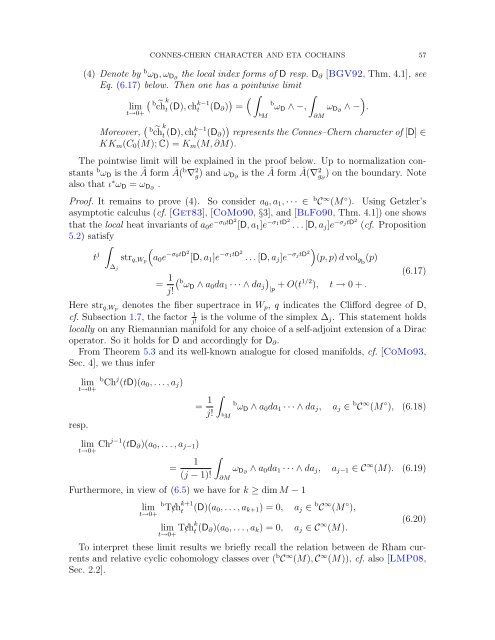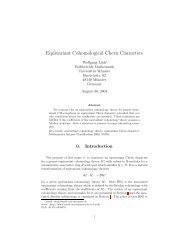Connes-Chern Character for Manifolds with Boundary and ETA ...
Connes-Chern Character for Manifolds with Boundary and ETA ...
Connes-Chern Character for Manifolds with Boundary and ETA ...
Create successful ePaper yourself
Turn your PDF publications into a flip-book with our unique Google optimized e-Paper software.
lim<br />
t→0+<br />
CONNES-CHERN CHARACTER AND <strong>ETA</strong> COCHAINS 57<br />
(4) Denote by b ω D , ω D∂ the local index <strong>for</strong>ms of D resp. D ∂ [BGV92, Thm. 4.1], see<br />
Eq. (6.17) below. Then one has a pointwise limit<br />
( b<br />
k<br />
˜ch t (D), ch k−1<br />
t (D ∂ ) ) ∫ )<br />
=<br />
b ω D ∧ −, ω D∂ ∧ − .<br />
( ∫b M<br />
Moreover, ( k<br />
b ˜ch t (D), ch k−1<br />
t (D ∂ ) ) represents the <strong>Connes</strong>–<strong>Chern</strong> character of [D] ∈<br />
KK m (C 0 (M); C) = K m (M, ∂M).<br />
The pointwise limit will be explained in the proof below. Up to normalization constants<br />
b ω D is the  <strong>for</strong>m Â(b ∇ 2 g) <strong>and</strong> ω D∂ is the  <strong>for</strong>m Â(∇2 g ∂<br />
) on the boundary. Note<br />
also that ι ∗ ω D = ω D∂ .<br />
Proof. It remains to prove (4). So consider a 0 , a 1 , · · · ∈ b C ∞ (M ◦ ). Using Getzler’s<br />
asymptotic calculus (cf. [Get83], [CoMo90, §3], <strong>and</strong> [BlFo90, Thm. 4.1]) one shows<br />
that the local heat invariants of a 0 e −σ 0tD 2 [D, a 1 ]e −σ 1tD 2 . . . [D, a j ]e −σ jtD 2 (cf. Proposition<br />
5.2) satisfy<br />
∫ (<br />
t j str q,Wp a 0 e −σ 0tD 2 [D, a 1 ]e −σ 1tD 2 . . . [D, a j ]e −σ jtD 2) (p, p) d vol gb (p)<br />
∆ j<br />
= 1 (6.17)<br />
( b<br />
)<br />
ω D ∧ a 0 da 1 · · · ∧ da j<br />
j!<br />
+ |p O(t1/2 ), t → 0 + .<br />
Here str q,Wp denotes the fiber supertrace in W p , q indicates the Clif<strong>for</strong>d degree of D,<br />
cf. Subsection 1.7, the factor 1 j!<br />
is the volume of the simplex ∆ j . This statement holds<br />
locally on any Riemannian manifold <strong>for</strong> any choice of a self-adjoint extension of a Dirac<br />
operator. So it holds <strong>for</strong> D <strong>and</strong> accordingly <strong>for</strong> D ∂ .<br />
From Theorem 5.3 <strong>and</strong> its well-known analogue <strong>for</strong> closed manifolds, cf. [CoMo93,<br />
Sec. 4], we thus infer<br />
∂M<br />
lim<br />
b Ch j (tD)(a 0 , . . . , a j )<br />
t→0+<br />
resp.<br />
= 1 ∫<br />
b ω D ∧ a 0 da 1 · · · ∧ da j , a j ∈ b C ∞ (M ◦ ), (6.18)<br />
j!<br />
b M<br />
lim<br />
t→0+ Chj−1 (tD ∂ )(a 0 , . . . , a j−1 )<br />
=<br />
1<br />
(j − 1)!<br />
Furthermore, in view of (6.5) we have <strong>for</strong> k ≥ dim M − 1<br />
∫<br />
∂M<br />
ω D∂ ∧ a 0 da 1 · · · ∧ da j , a j−1 ∈ C ∞ (M). (6.19)<br />
lim<br />
b T/ch k+1<br />
t→0+<br />
t<br />
(D)(a 0 , . . . , a k+1 ) = 0, a j ∈ b C ∞ (M ◦ ),<br />
lim<br />
t→0+ T/chk t (D ∂)(a 0 , . . . , a k ) = 0,<br />
a j ∈ C ∞ (M).<br />
(6.20)<br />
To interpret these limit results we briefly recall the relation between de Rham currents<br />
<strong>and</strong> relative cyclic cohomology classes over ( b C ∞ (M), C ∞ (M)), cf. also [LMP08,<br />
Sec. 2.2].

















